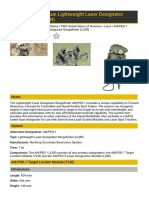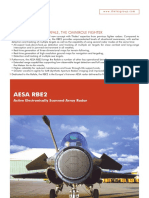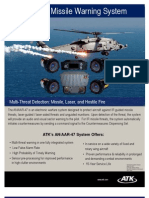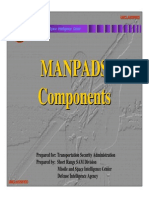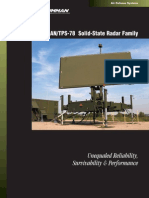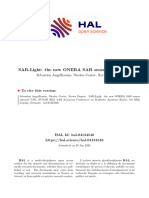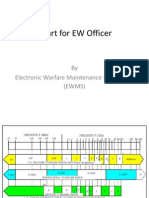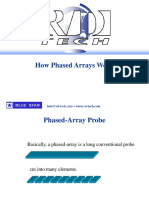100%(3)100% found this document useful (3 votes)
1K viewsFact Sheet - Big Bird
Fact Sheet - Big Bird
Uploaded by
Nick NumlkThe 64N6E Big Bird radar is a key component of improved engagement capabilities in later S-300P variants. It is a phased array radar operating in S-band that has a larger aperture than the US Navy SPY-1 radar. The Big Bird can concurrently search two 90 degree sectors using electronic beam steering and mechanical rotation. It can detect small fighter targets at ranges over 140 nautical miles and track multiple targets for interception. The Big Bird provides excellent target acquisition but was paired with the inadequate 5V55 missile. Later variants paired it with the 48N6 missile having better performance against air and ballistic missile targets.
Copyright:
© All Rights Reserved
Available Formats
Download as DOCX, PDF, TXT or read online from Scribd
Fact Sheet - Big Bird
Fact Sheet - Big Bird
Uploaded by
Nick Numlk100%(3)100% found this document useful (3 votes)
1K views2 pagesThe 64N6E Big Bird radar is a key component of improved engagement capabilities in later S-300P variants. It is a phased array radar operating in S-band that has a larger aperture than the US Navy SPY-1 radar. The Big Bird can concurrently search two 90 degree sectors using electronic beam steering and mechanical rotation. It can detect small fighter targets at ranges over 140 nautical miles and track multiple targets for interception. The Big Bird provides excellent target acquisition but was paired with the inadequate 5V55 missile. Later variants paired it with the 48N6 missile having better performance against air and ballistic missile targets.
Original Description:
Fact Sheet - Big Bird
Copyright
© © All Rights Reserved
Available Formats
DOCX, PDF, TXT or read online from Scribd
Share this document
Did you find this document useful?
Is this content inappropriate?
The 64N6E Big Bird radar is a key component of improved engagement capabilities in later S-300P variants. It is a phased array radar operating in S-band that has a larger aperture than the US Navy SPY-1 radar. The Big Bird can concurrently search two 90 degree sectors using electronic beam steering and mechanical rotation. It can detect small fighter targets at ranges over 140 nautical miles and track multiple targets for interception. The Big Bird provides excellent target acquisition but was paired with the inadequate 5V55 missile. Later variants paired it with the 48N6 missile having better performance against air and ballistic missile targets.
Copyright:
© All Rights Reserved
Available Formats
Download as DOCX, PDF, TXT or read online from Scribd
Download as docx, pdf, or txt
100%(3)100% found this document useful (3 votes)
1K views2 pagesFact Sheet - Big Bird
Fact Sheet - Big Bird
Uploaded by
Nick NumlkThe 64N6E Big Bird radar is a key component of improved engagement capabilities in later S-300P variants. It is a phased array radar operating in S-band that has a larger aperture than the US Navy SPY-1 radar. The Big Bird can concurrently search two 90 degree sectors using electronic beam steering and mechanical rotation. It can detect small fighter targets at ranges over 140 nautical miles and track multiple targets for interception. The Big Bird provides excellent target acquisition but was paired with the inadequate 5V55 missile. Later variants paired it with the 48N6 missile having better performance against air and ballistic missile targets.
Copyright:
© All Rights Reserved
Available Formats
Download as DOCX, PDF, TXT or read online from Scribd
Download as docx, pdf, or txt
You are on page 1of 2
BIG BIRD - Low Level EW & ACQ Radar
Frequency (Freq) [MHz] 2000 (S-band)
Pulse Width (PW) [us] FMCW
Pulse Repetition Frequency (PRF) [Hz] -
Pulse Repetition Interval (PRI) [us] -
Peak Power [kw] 700
Average Power [kw] 0.7
Displayed Range [km] About 450
Range Resolution [m] 180
Mainlobe Width [degree] 2
Sweep Rate [RPM] 6
Deploy/Stow Time [min] About 60
Pic 1 5N66M Big Bird
Descriptions
The 64N6E Big Bird is the key to much of the improved engagement capability, and ballistic
missile intercept capability in the later S-300P variants. This system operates in the 2 GHz band
and is a phased array with a 30% larger aperture than the US Navy SPY-1 Aegis radar, even
accounting for its slightly larger wavelength it amounts to a mobile land based Aegis class
package. It has no direct equivalent in the West.
Like other components of the S-300PM system, the 64N6E has a number of unique and lateral
design features. The radar antenna is mounted on a cabin, in turn mounted on a turntable
permitting 360 degree rotation. Unlike Western phased arrays in this class, the 64N6 uses a
reflective phased array with a front face horn feed, the horn placed at the end of the long boom
which protects the waveguides to the transmitters and receivers in the cabin. The beam steering
electronics are embedded inside the antenna array, which has around 2700 phase elements on
either face. This Janus faced arrangement permits the Big Bird to concurrently search two 90
degree sectors, in opposite directions, using mechanical rotation to position the antenna and
electronic beam steering in azimuth and elevation. This design technique permits incremental
growth in output power as the only components of the system which have to handle high
microwave power levels are the waveguide and feed horn.
The 64N6E is a frequency hopper, and incorporates additional auxiliary antenna/receiver
channels for suppression of sidelobe jammers - NIIP claim the ability to measure accurate
bearing to jamming sources. The back end processing is Moving Target Indicator (MTI), and like
the Aegis the system software can partition the instantaneous sector being covered into smaller
zones for specific searches. To enhance MTI performance the system can make use of stored
clutter returns from multiple preceding sweeps. Detection ranges for small fighter targets are of
the order of 140 to 150 nautical miles for early variants. Per 12 second sweep 200 targets can be
detected, and either six or twelve can be individually tracked for engagements.
While the Big Bird provides an excellent acquisition capability against aerial and ballistic missile
targets, the 5V55 missile was inadequate. The S-300PM/PMU1 introduced the 48N6 which has
much better kinematics - cited range against aerial targets is 81 nautical miles, ballistic missile
targets 21.5 nautical miles, with a minimum engagement range of 1.6 to 2.7 nautical miles. Low
altitude engagement capabilities were improved - down to 20 - 30 ft AGL. The missile speed
peaks at 2,100 metres/sec or cca Mach 6. The missiles can be fired at 3 second intervals, and
Russian sources claim a single shot kill probability of 80% to 93% for aerial targets, 40% to 85%
for cruise missiles and 50% to 77% for TBMs.
The latest variant is the 91N6E developed for the S-400 Triumf / SA-21 system. It is known to be
a fully digital design with a higher peak power rating than the 64N6E2 to accommodate the
longer ranging 48N6E3 and 40N6E missiles.
You might also like
- Land Based SensorsDocument40 pagesLand Based SensorsJ.MichaelLooneyNo ratings yet
- Radar Missile Seekers: Chris J. Baker and Anthony ZyweckDocument10 pagesRadar Missile Seekers: Chris J. Baker and Anthony ZyweckrehanNo ratings yet
- Active Electronically Scanned Array: HistoryDocument9 pagesActive Electronically Scanned Array: Historyram5584100% (1)
- 99-881-0001-0001-Combat Systems Vol 1 Sensor Elements Part-IDocument602 pages99-881-0001-0001-Combat Systems Vol 1 Sensor Elements Part-INick NumlkNo ratings yet
- Fact Sheet - Bill BoardDocument2 pagesFact Sheet - Bill BoardNick Numlk100% (1)
- Fact Sheet - Clam ShellDocument2 pagesFact Sheet - Clam ShellNick NumlkNo ratings yet
- SeekerDocument8 pagesSeekeralper797No ratings yet
- Fact Sheet - Tin ShieldDocument2 pagesFact Sheet - Tin ShieldNick NumlkNo ratings yet
- APG66Document8 pagesAPG66green_equation100% (1)
- Bars RadarDocument3 pagesBars RadarAnonymous wYO0fXHP2No ratings yet
- Recent Developments in Russian Radar SystemsDocument7 pagesRecent Developments in Russian Radar SystemsDhimas Afihandarin100% (3)
- Making AESE More FlexibleDocument3 pagesMaking AESE More FlexiblePhan Xuân TuấnNo ratings yet
- Semi ActiveDocument7 pagesSemi ActiveNick NumlkNo ratings yet
- Military Laser Technology for Defense: Technology for Revolutionizing 21st Century WarfareFrom EverandMilitary Laser Technology for Defense: Technology for Revolutionizing 21st Century WarfareNo ratings yet
- Fact Sheet - Snow DriftDocument1 pageFact Sheet - Snow DriftNick Numlk0% (1)
- Fact Sheet - Fan SongDocument4 pagesFact Sheet - Fan SongNick NumlkNo ratings yet
- Fact Sheet - Bar LockDocument2 pagesFact Sheet - Bar LockNick Numlk100% (1)
- X Band T/R Modules: ApplicationsDocument2 pagesX Band T/R Modules: ApplicationsHassan MehmoodNo ratings yet
- Risk Management Lessons Learned From The APG - 79 Radar Test Planning and ExecutionDocument51 pagesRisk Management Lessons Learned From The APG - 79 Radar Test Planning and Executionjade8880No ratings yet
- 200901021214101Document6 pages200901021214101gabriel99669966100% (1)
- The Sixth Generation Fighter: by John A. Tirpak, Executive EditorDocument5 pagesThe Sixth Generation Fighter: by John A. Tirpak, Executive Editornaveed100% (2)
- Grifo eDocument2 pagesGrifo eManuel SolisNo ratings yet
- A DarterDocument2 pagesA DarterManuel SolisNo ratings yet
- Aesa Rbe2: Aesa Radar For The Rafale, The Omnirole FighterDocument2 pagesAesa Rbe2: Aesa Radar For The Rafale, The Omnirole FighterAfeef Ibn AlbraNo ratings yet
- Pirate IRST Infrared Search and Track LQ Mm07797Document2 pagesPirate IRST Infrared Search and Track LQ Mm07797Luis MartinezNo ratings yet
- Harpoon Block IIDocument2 pagesHarpoon Block IIVictor PileggiNo ratings yet
- Car RadarDocument17 pagesCar RadarRohit Narain100% (2)
- The Airborne ISR Market 2013-2023 PDFDocument24 pagesThe Airborne ISR Market 2013-2023 PDFVisiongainGlobal100% (1)
- AN-APG-63 3 DetalleDocument5 pagesAN-APG-63 3 DetalleJosé Luis Delgado100% (1)
- UAV Specs PDFDocument12 pagesUAV Specs PDFMario Gómez Martínez100% (1)
- Rq-4 Block 20 Global Hawk: Structural FeaturesDocument5 pagesRq-4 Block 20 Global Hawk: Structural FeaturesTuğba BüyüktanırNo ratings yet
- Aesa TechpaperDocument17 pagesAesa TechpaperosmanriazNo ratings yet
- Fighters Feature Electronic Attack: AESA Radars and UpgradesDocument4 pagesFighters Feature Electronic Attack: AESA Radars and Upgradesslicendice123No ratings yet
- AN/AAR-47 Missile Warning System: Multi-Threat Detection: Missile, Laser, and Hostile FireDocument2 pagesAN/AAR-47 Missile Warning System: Multi-Threat Detection: Missile, Laser, and Hostile Firesd_hosseini_88No ratings yet
- Weapon SystemsDocument14 pagesWeapon SystemsschultzNo ratings yet
- Smallsat Cubesat IDocument61 pagesSmallsat Cubesat IVisal KelNo ratings yet
- Manpads ComponentsDocument16 pagesManpads ComponentsNick NumlkNo ratings yet
- Radar 2009Document50 pagesRadar 2009FelyNo ratings yet
- Air Defence System Defensive EquipmentDocument20 pagesAir Defence System Defensive Equipmentzix013100% (1)
- Sar Uav PDFDocument24 pagesSar Uav PDFadityaNo ratings yet
- Lecture 08Document27 pagesLecture 08Malakonda ReddyNo ratings yet
- Jammer BVRDocument13 pagesJammer BVRViperDriverNo ratings yet
- Multi-Channel Transmit/receive Modules For X-Band AesaDocument3 pagesMulti-Channel Transmit/receive Modules For X-Band AesaDhimas AfihandarinNo ratings yet
- APG-67 Multimode RadarDocument2 pagesAPG-67 Multimode RadarGuy RamsdenNo ratings yet
- BOEING - SLAM-ER (Standoff Land Attack Missile-Expanded Response) PDFDocument2 pagesBOEING - SLAM-ER (Standoff Land Attack Missile-Expanded Response) PDFWan Luqman Noor100% (1)
- Grifo e MM08942 LQ PDFDocument2 pagesGrifo e MM08942 LQ PDFToufeeque AhmedNo ratings yet
- Brimstone DataDocument2 pagesBrimstone Databobmartin00100% (1)
- S 300VDocument49 pagesS 300VSohail SafeerNo ratings yet
- Air Defence System UpgradesDocument63 pagesAir Defence System Upgradesserrorys100% (1)
- Engagement and Fire Control Radars (S-Band, X-Band)Document73 pagesEngagement and Fire Control Radars (S-Band, X-Band)rgt89hw-g0h8-100% (4)
- 6Th Generation Fighter 6Th Generation Fighter: What Will TheDocument2 pages6Th Generation Fighter 6Th Generation Fighter: What Will TheCarlo AlvaradoNo ratings yet
- Airborne Integrated Signal Intelligence System: When Results MatterDocument2 pagesAirborne Integrated Signal Intelligence System: When Results Mattersamirsamira928No ratings yet
- F-15E Radar Modernization Program (RMP)Document2 pagesF-15E Radar Modernization Program (RMP)joma11No ratings yet
- Kongsberg - LASAR 5 - Coastal Surveillance SonarDocument2 pagesKongsberg - LASAR 5 - Coastal Surveillance SonarGurit Perdana100% (1)
- Radar 3D AN/TPS78 Solid State FamilyDocument6 pagesRadar 3D AN/TPS78 Solid State Familyrccngs100% (1)
- Ada System From OdinDocument415 pagesAda System From OdinJ.MichaelLooney100% (2)
- Silent Knight RadarDocument9 pagesSilent Knight RadarThinkDefence100% (3)
- Operation GOTCHA: The Soviet Union's Top-Secret Plan to Launch a Surprise Cruise Missile Attack Against the United StatesFrom EverandOperation GOTCHA: The Soviet Union's Top-Secret Plan to Launch a Surprise Cruise Missile Attack Against the United StatesNo ratings yet
- 7 e 3 Ede 66Document3 pages7 e 3 Ede 66Олег ПоборцевNo ratings yet
- (2005) Advances in Active Radar Seeker TechnologyDocument8 pages(2005) Advances in Active Radar Seeker TechnologyAlex Yang100% (2)
- ONERA Light SAR on DJIDocument5 pagesONERA Light SAR on DJIRational BeeNo ratings yet
- Manpads ComponentsDocument16 pagesManpads ComponentsNick NumlkNo ratings yet
- F 16 Platform BrochureDocument16 pagesF 16 Platform BrochureNick Numlk50% (2)
- B 0150061212Document4 pagesB 0150061212Nick NumlkNo ratings yet
- 14313A ch10Document32 pages14313A ch10Nick NumlkNo ratings yet
- EKKO II - Digital RadarjammingDocument2 pagesEKKO II - Digital RadarjammingNick NumlkNo ratings yet
- Chart For EW OfficerDocument13 pagesChart For EW OfficerNick NumlkNo ratings yet
- Worldwide Equipment GuideDocument414 pagesWorldwide Equipment Guidealex.rocha_silva9359100% (17)
- Fact Sheet - Fan SongDocument4 pagesFact Sheet - Fan SongNick NumlkNo ratings yet
- Fact Sheet - Snow DriftDocument1 pageFact Sheet - Snow DriftNick Numlk0% (1)
- Naval 1Document12 pagesNaval 1Nick NumlkNo ratings yet
- Fact Sheet - Bar LockDocument2 pagesFact Sheet - Bar LockNick Numlk100% (1)
- Manpads ComponentsDocument16 pagesManpads ComponentsNick NumlkNo ratings yet
- Sa-3 GoaDocument5 pagesSa-3 GoaNick Numlk100% (2)
- Example: Terminal StackingDocument40 pagesExample: Terminal StackingNick NumlkNo ratings yet
- Russian Military AircraftDocument219 pagesRussian Military AircraftJohn John100% (1)
- THURBONDocument2 pagesTHURBONNick NumlkNo ratings yet
- A Comprehensive Analysis On The State-Of-The-Artdevelopments in Reflectarray, Transmitarray, and Transmit-Reflectarray AntennasDocument22 pagesA Comprehensive Analysis On The State-Of-The-Artdevelopments in Reflectarray, Transmitarray, and Transmit-Reflectarray AntennasZohre NoamadeNo ratings yet
- Power OscillatorDocument8 pagesPower OscillatorEnos Marcos BastosNo ratings yet
- P2133500 PDFDocument12 pagesP2133500 PDFxongassilvaNo ratings yet
- 06 Radar Antennas PDFDocument37 pages06 Radar Antennas PDFRisqi RaharjoNo ratings yet
- Application of Machine Learning Techniques in Phased Array Antenna Synthesis: A Comprehensive Mini ReviewDocument14 pagesApplication of Machine Learning Techniques in Phased Array Antenna Synthesis: A Comprehensive Mini ReviewAmit GhoshNo ratings yet
- ASTM 2491 - 08 PhaseArray PDFDocument18 pagesASTM 2491 - 08 PhaseArray PDFOmero MeraNo ratings yet
- Vehicle Density Based Smart Traffic Control System Using PLCDocument40 pagesVehicle Density Based Smart Traffic Control System Using PLCUmang MewaraNo ratings yet
- OmniSX MX2 Training 4C Phased Array WedgesDocument37 pagesOmniSX MX2 Training 4C Phased Array WedgescarlosNo ratings yet
- Project 6 - Linear and Planar Antenna Array Analysis in MATLAB (May 2014)Document9 pagesProject 6 - Linear and Planar Antenna Array Analysis in MATLAB (May 2014)Stephen J. Watt100% (1)
- Introduction To Tofd & Phased Arrays Industrial ApplicationsDocument49 pagesIntroduction To Tofd & Phased Arrays Industrial Applicationschitturi jagadishNo ratings yet
- PA Probe Catalog EN 201608 Web PDFDocument32 pagesPA Probe Catalog EN 201608 Web PDFDennis Chai100% (1)
- Kathrein BTS Antenas ConceptsDocument44 pagesKathrein BTS Antenas Conceptsphenom1979No ratings yet
- Index: Index Terms Links ADocument69 pagesIndex: Index Terms Links ASusana Rojas100% (1)
- SyncScan Brochure FDocument8 pagesSyncScan Brochure FHenry CruzNo ratings yet
- A Dual-Polarized Dual-Beam 28 GHZ Beamformer Chip Demonstrating A 24 Gbps 64-Qam 2X2 Mimo LinkDocument4 pagesA Dual-Polarized Dual-Beam 28 GHZ Beamformer Chip Demonstrating A 24 Gbps 64-Qam 2X2 Mimo LinkBalaNo ratings yet
- 23 GinzelDocument12 pages23 Ginzelmusaismail8863No ratings yet
- Advantages of (PAUT) & (TOFD)Document13 pagesAdvantages of (PAUT) & (TOFD)Lương Hồ Vũ100% (1)
- Ship Phase Array RadarsDocument12 pagesShip Phase Array RadarsDefenceDogNo ratings yet
- Basic Phased Arrays TrainingDocument19 pagesBasic Phased Arrays TrainingLương Hồ VũNo ratings yet
- Daisy Phased Array ProbesDocument2 pagesDaisy Phased Array ProbesRamakrishnan AmbiSubbiahNo ratings yet
- Types of TransducersDocument33 pagesTypes of TransducersShoSheetaNo ratings yet
- Research Paper On Antenna DesignDocument4 pagesResearch Paper On Antenna Designcasm6bby100% (1)
- MX2 Training Program 13 Multiprobe InspectionDocument8 pagesMX2 Training Program 13 Multiprobe InspectionVictor Antonio Diaz FaundezNo ratings yet
- The Effect of Random Amplitude and Phase Errors On Phased Arrays PerformanceDocument6 pagesThe Effect of Random Amplitude and Phase Errors On Phased Arrays PerformanceFurkan Bahadır Elik100% (1)
- Radar ProjectDocument42 pagesRadar Projectgautam yadavNo ratings yet
- NDT Ultrasonic TestingDocument3 pagesNDT Ultrasonic TestingSpace UnionNo ratings yet
- Digital Control Board For Phased Array Antenna Beam Steering in ADocument115 pagesDigital Control Board For Phased Array Antenna Beam Steering in AJaime LazoNo ratings yet
- Detection of Hydrogen-Induced Cracking (Hic) : Using Omniscan™ Pa General Description of The ApplicationDocument2 pagesDetection of Hydrogen-Induced Cracking (Hic) : Using Omniscan™ Pa General Description of The ApplicationEur-Ing Nicola GalluzziNo ratings yet
- PA Probe Catalog en 201308Document24 pagesPA Probe Catalog en 201308Alvaro Alexis Mendoza PradaNo ratings yet
- Phase ShiftersDocument14 pagesPhase Shiftersgurnamsaluja2007No ratings yet
